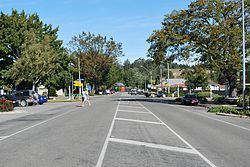Country New Zealand Territorial authority Postcode 7310 Local time Sunday 3:07 AM | Region Canterbury Elevation 60 m (200 ft) Population 369 (2013) | |
 | ||
Weather 15°C, Wind W at 18 km/h, 68% Humidity | ||
Ribbonwood country house cheviot new zealand hd review
Cheviot /ˈtʃᵻvɪərt/ is a town in the Hurunui District of north Canterbury, on the east coast of the South Island of New Zealand. It is on State Highway 1 approximately 110 kilometres (68 mi) north of Christchurch.
Contents
- Ribbonwood country house cheviot new zealand hd review
- Map of Cheviot New Zealand
- History and naming
- Demographics
- The region
- Domett
- Spotswood
- Parnassus
- Gore Bay
- Port Robinson
- Stonyhurst Station
- Education
- References
Map of Cheviot, New Zealand
History and naming
The government under Minister of Lands John McKenzie bought the Cheviot Hills estate from the descendants of William Robinson. The Cheviot Hills estate was broken into 54 farms and a township, which was originally called Mackenzie. This name was "in widespread use for a decade or two" but gradually fell into disuse. The post office was always known as Cheviot and by at least 1913 the township too was generally known as Cheviot. Cheviot Hills estate had been named by its original lease holder, John Scott Taverhill, after his home country, the Cheviot Hills straddling the Anglo-Scottish border.
Demographics
According to the 2013 New Zealand census, the population of Cheviot was 369—a decrease of 21 from the previous 2006 census of 390, which in turn was a decrease of three from the previous 2001 census. A further 980 people lived in the rural areas serviced by the town or in adjacent villages such as Domett, Parnassus, Gore Bay and Port Robinson.
The region
Cheviot is a service town for highway traffic and for a pastoral farming district that is currently predominant in sheep farming. Based in the township are a volunteer fire and ambulance services and one full-time police officer. Surrounding settlements include:
Domett
Domett (pronounced Do-mett), originally a railway town, is now only populated by farms and a petrol station, with the Old Main Road/Hurunui River Mouth Road junction. Next to this junction is the old Domett Railway Station, relocated as a cafe. Domett Service Station provides after-hours sale of fuel (with surcharge): most service stations in the area close around 6pm.
Spotswood
Spotswood has an old hall that is still used regularly, and mainly consists of farms around Waiau East Road.
Parnassus
Parnassus is slightly larger than the others but the local Parnassus School has recently shut down. The famous Waiau River road/rail bridge was here, before being abandoned and replaced with a new road bridge. Prior to the opening of the old bridge in the 1930s a ferry across the river carried goods north and south. The Waiau River ends not far away however access to the river mouth must be made over farm property with the owner's permission. On the State Highway north of Parnassus is Leader Road which leads to the townships of Waiau, Rotherham, Culverden and Hanmer Springs.
Gore Bay
Gore Bay is a surfing beach with summer beach houses and 14 permanent residents. There are two local camping grounds, each with beach access and business. It is a popular New Year's Eve venue.
Of note is Cathedral Gully, a spectacular weathered clay canyon.
Port Robinson
Once a prospering port, Port Robinson is now just a wreck. The old wharf may still be seen, but it is rather dangerous.
Stonyhurst Station
Stonyhurst is a farming station in the Blythe Valley, southwest of Cheviot.
It was founded in 1851 by Frederick Weld and Charles Clifford. He had gained his impression when walking from Lyttelton to Flaxbourne, in Marlborough. Clifford landed sheep on the beach just south of the Blythe River which was later be going to be known as Stonyhurst Station, named after Stonyhurst College in England where they were both educated.
The farm originally occupied nearly 30,000 hectares (74,000 acres), the whole of the Blythe Valley. About 12,000 hectares (30,000 acres) was sold in 1863, and a further 4,000 hectares (9,900 acres) a decade later. In about 1900, much of the rest of the land was subdivided. The current station is about one tenth of the original area.
The area is described by the local authority as "a potentially significant natural area", and the manager's cottage is a Category II protected building under the Historic Places Act.
Education
Schooling in Cheviot commenced in 1894. The first school was the McKenzie School, where the A&P Showgrounds are today. The name changed to Cheviot School in 1931.From its inception, the school provided primary education up to Form Two only. In 1937, it became the Cheviot District High School.
Cheviot Area School is a composite, co-educational school catering for Year 1-13 students. It also has a wider role providing continuing education, facilities and support for community groups. The closest main contributing school, Parnassus, a year 1-6 school closed in 2008. The community contains two pre-schools - Cheviot Learning Centre and The Tree Hut. There is very strong community support for the school and an active Home & School Association.
Cheviot Area School competes in the CASAFest (Canterbury Area Schools Association Festival) sporting competition with schools in Akaroa, Amuri, Hawarden, Oxford, and Rangiora.
The school partakes in international exchanges with schools in Japan and Canada.
